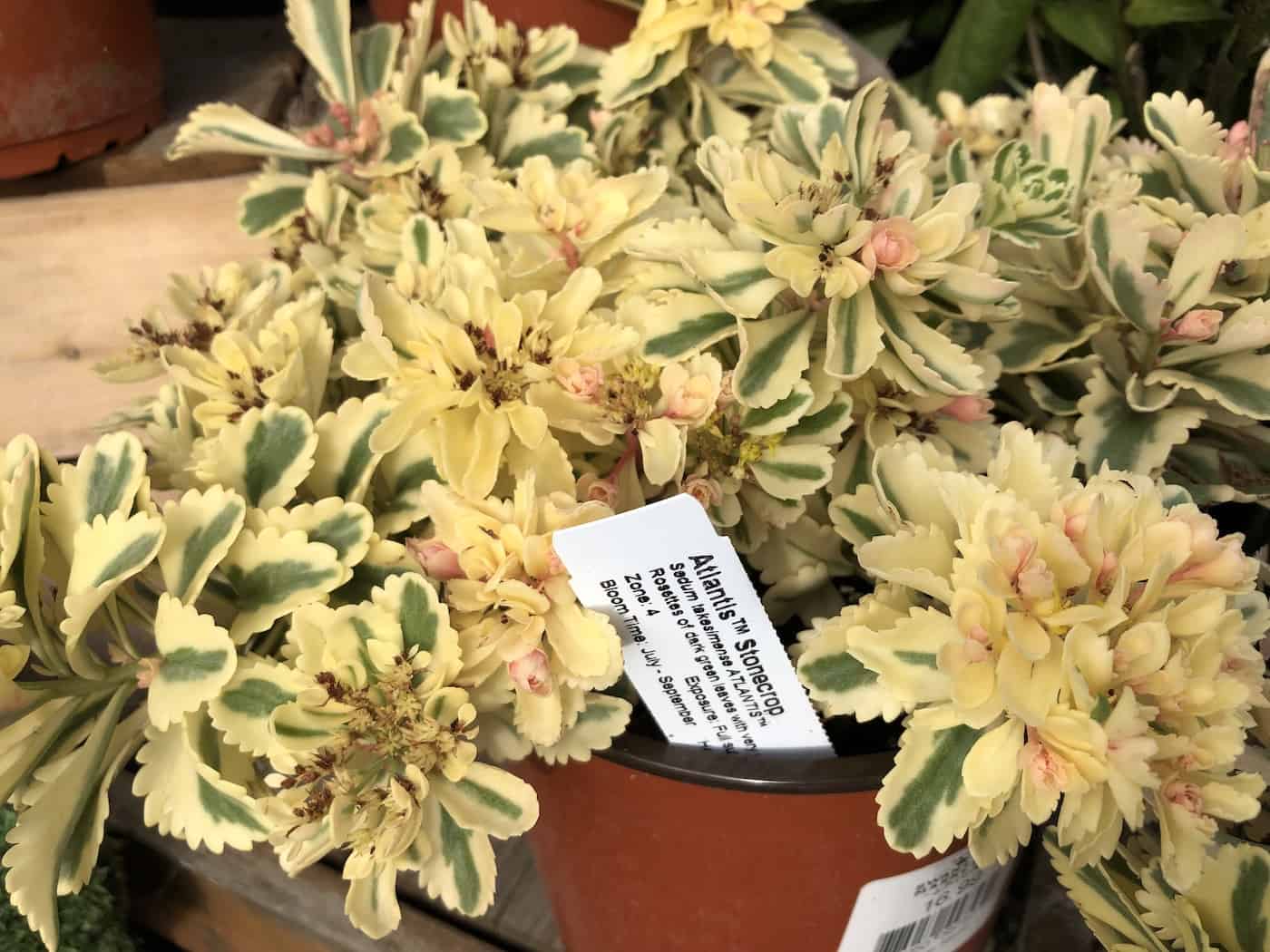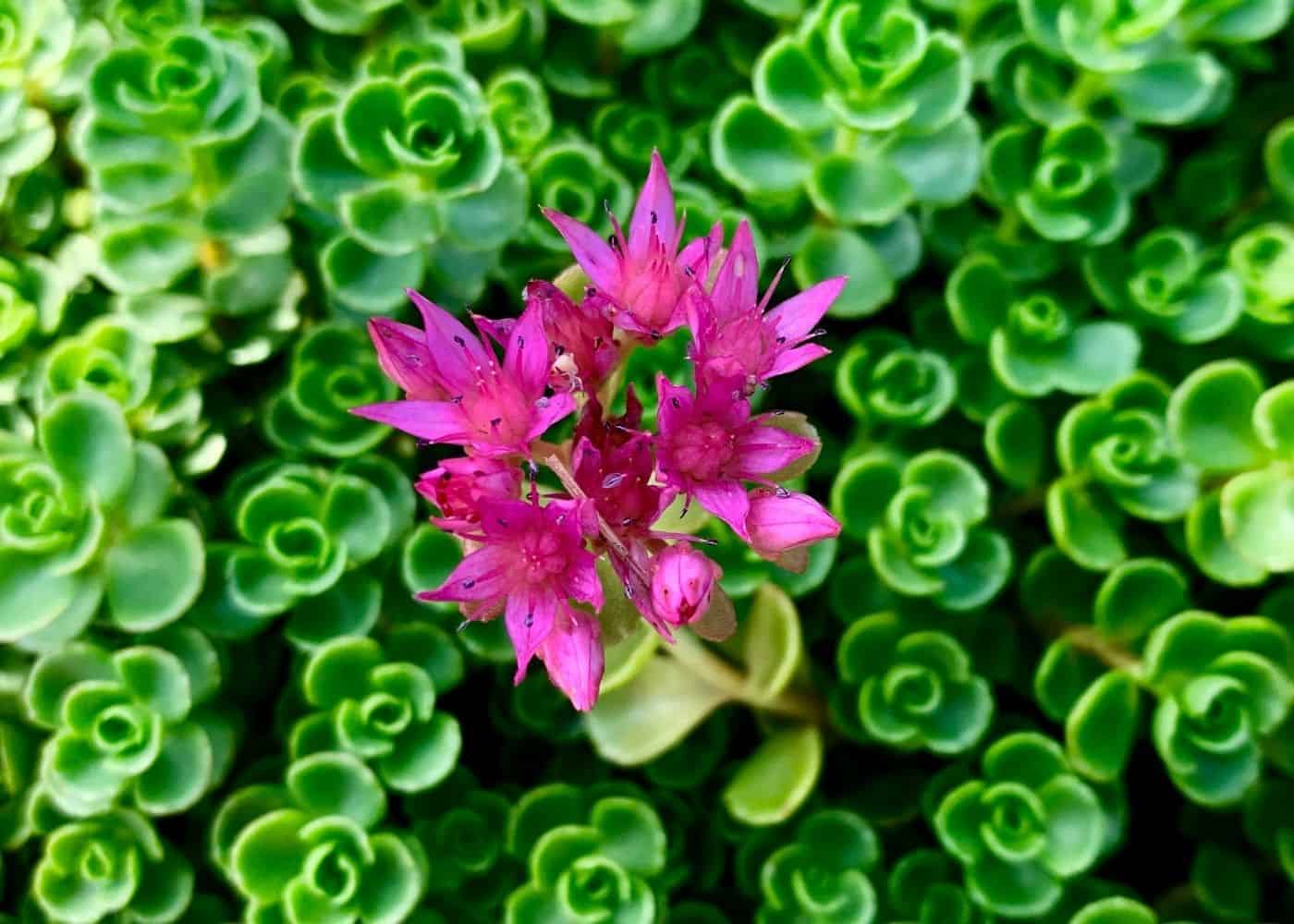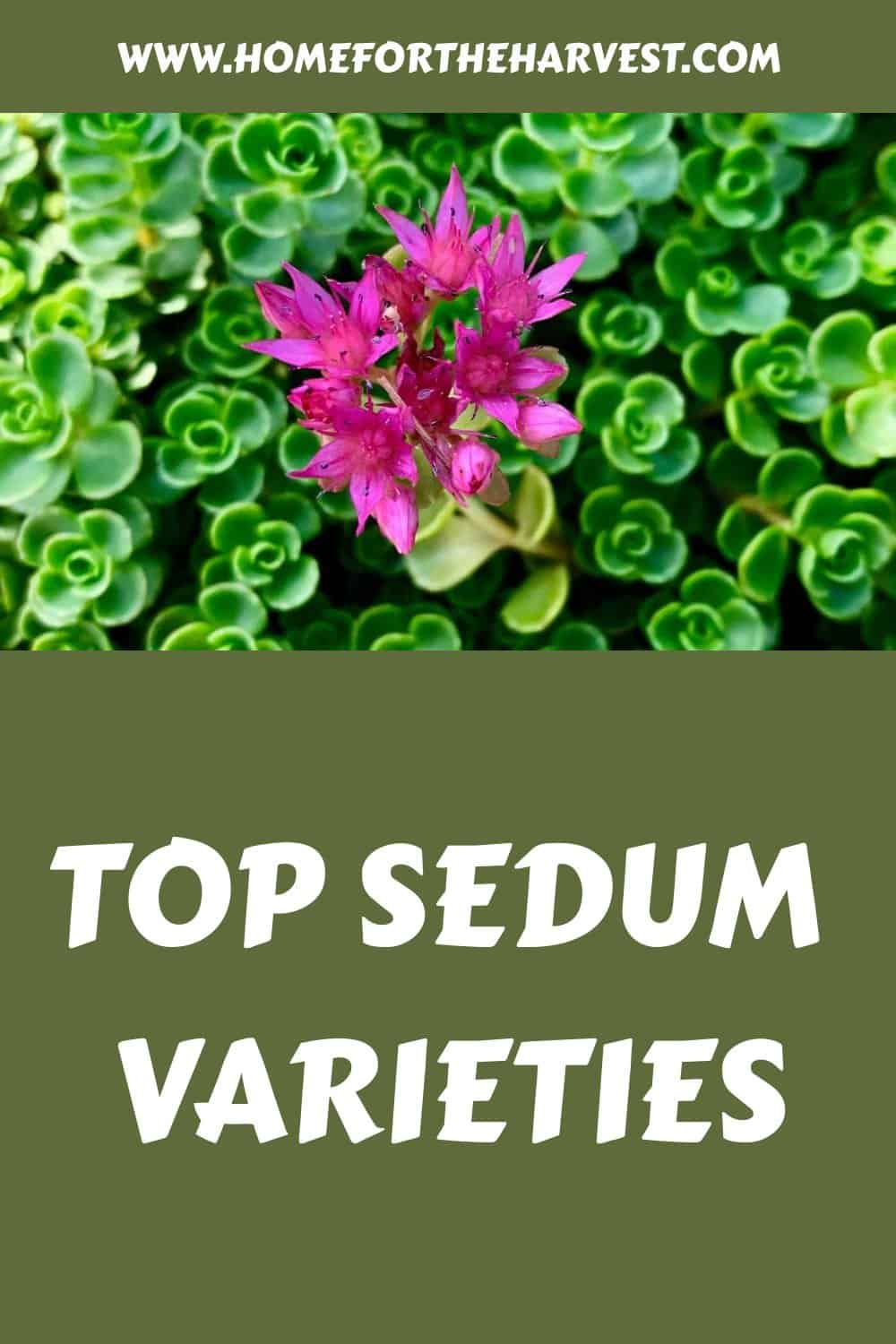Sedum plants are available in an incredible range of colors, shapes, and sizes. Here are 20 of the most popular Sedum varieties to try growing next in your rock garden or container planter!
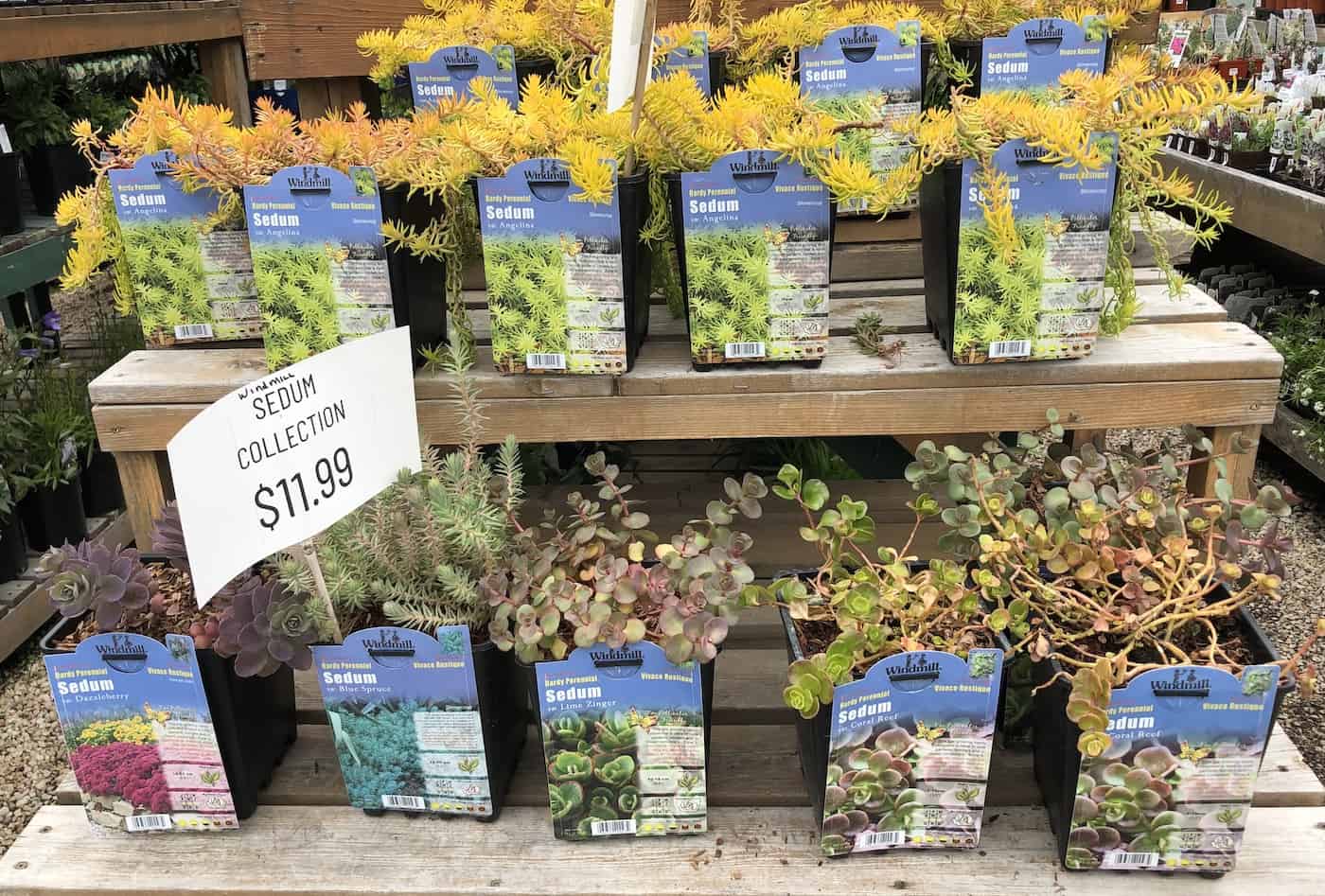
Botanical note: Sedum plants tend to be low-growing perennials that are often tolerant of dry soil conditions. Many types are evergreen in mild climates. While some plants formerly classified as Sedum are now classified as Hylotelephium, most are still commonly referred to as types of Sedum.
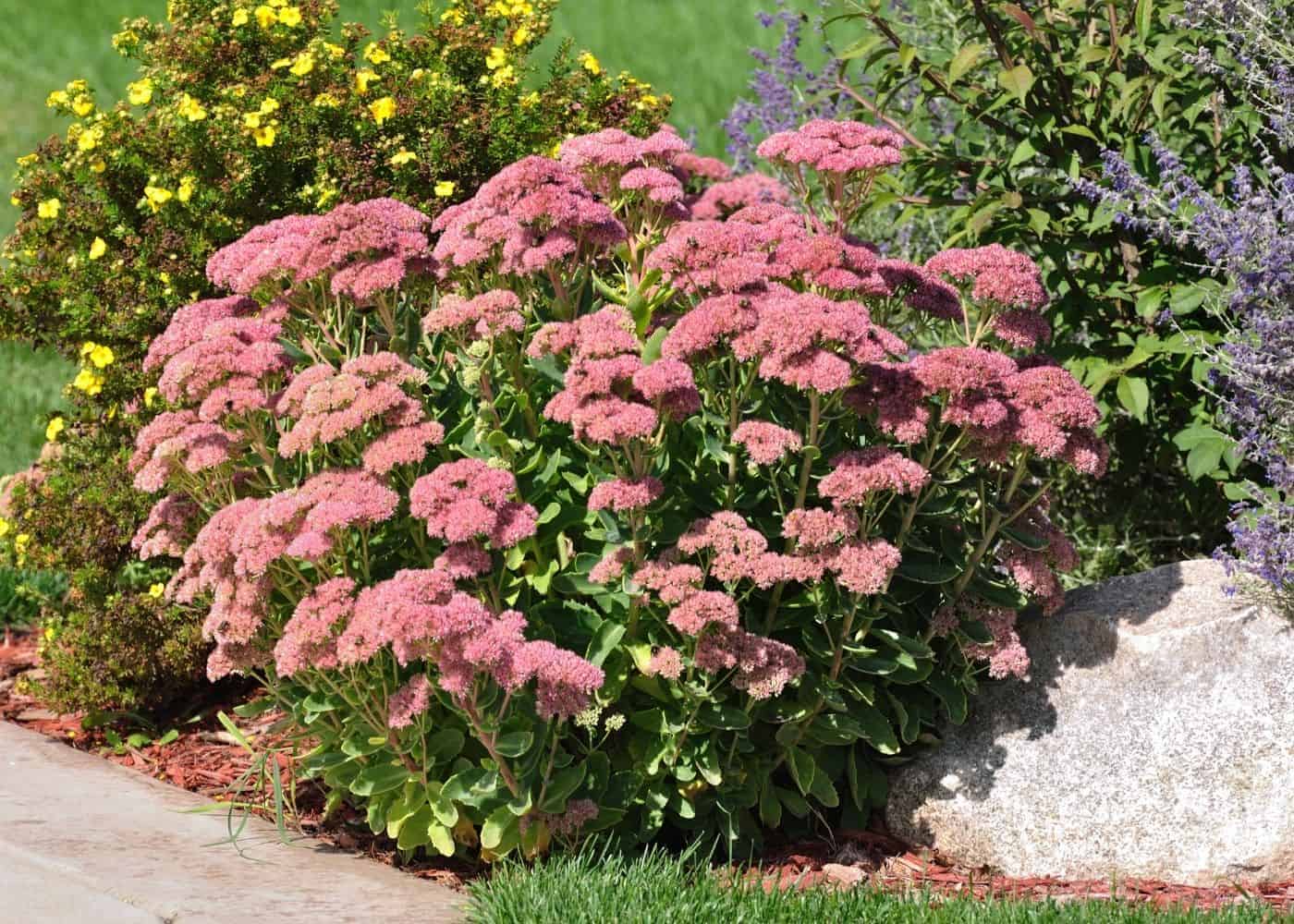
1. Autumn Joy Sedum
Autumn Joy Sedum (Hylotelephium ‘Herbstfreude’) is one of the most popular Sedum varieties. This type of Sedum produces masses of pink flowers that bloom in September-October. Autumn Joy Sedum is a modern introduction from Germany that can be grown in Zones 3-9. Autumn Joy Sedum (Hylotelephium ‘Herbstfreude’) is also called Autumn Joy Stonecrop or Herbstfreude Stonecrop.
Autumn Joy Sedum grows best in full-sun planting locations that receive at least 6-8 hours of direct sunlight per day. They thrive in well-drained soil and are tolerant of nutrient-poor soils. Autumn Joy is an upright Sedum, with plants typically grow to 18″-14″ tall each summer. Read more about Autumn Joy Sedum. Autumn Joy Sedum (Hylotelephium ‘Herbstfreude’) received the RHS Award of Garden Merit in 1993 (and is also an early fall favorite of beneficial pollinators like bees and hummingbirds).
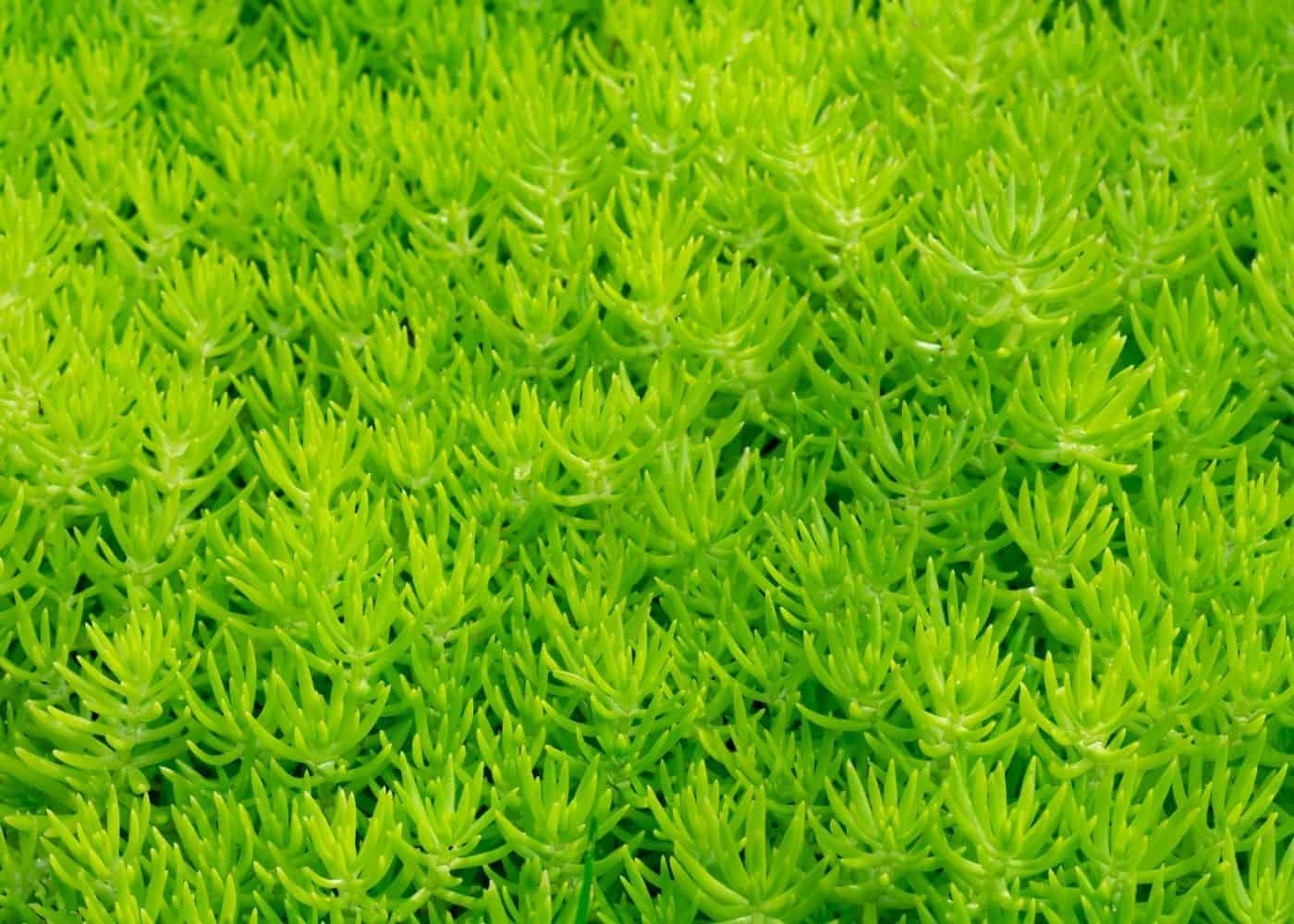
2. Angelina Sedum
Angelina Sedum (Sedum rupestre ‘Angelina’) is a popular Sedum cultivar with yellow flowers that bloom in June-August. Sedum rupestre is native to Europe and can be grown in Zones 5-8. Sedum rupestre is also called Rocky Stonecrop or Reflexed Stonecrop. ‘Angelina’ Sedum is a specific cultivar known for its attractive pointed yellow leaves which can bring a bright pop of color to rock gardens and xeriscaped areas in mid to late summer.
Angelina Sedum is a sun-loving species of Sedum. It grows best in full-sun areas with at least 6-8 hours of direct sunlight per day. Sedum rupestre ‘Angelina’ is drought-tolerant, and can be grown in low-water climates (although it does require supplemental watering in particularly dry climates). Established plants tend to grow 6″ tall.
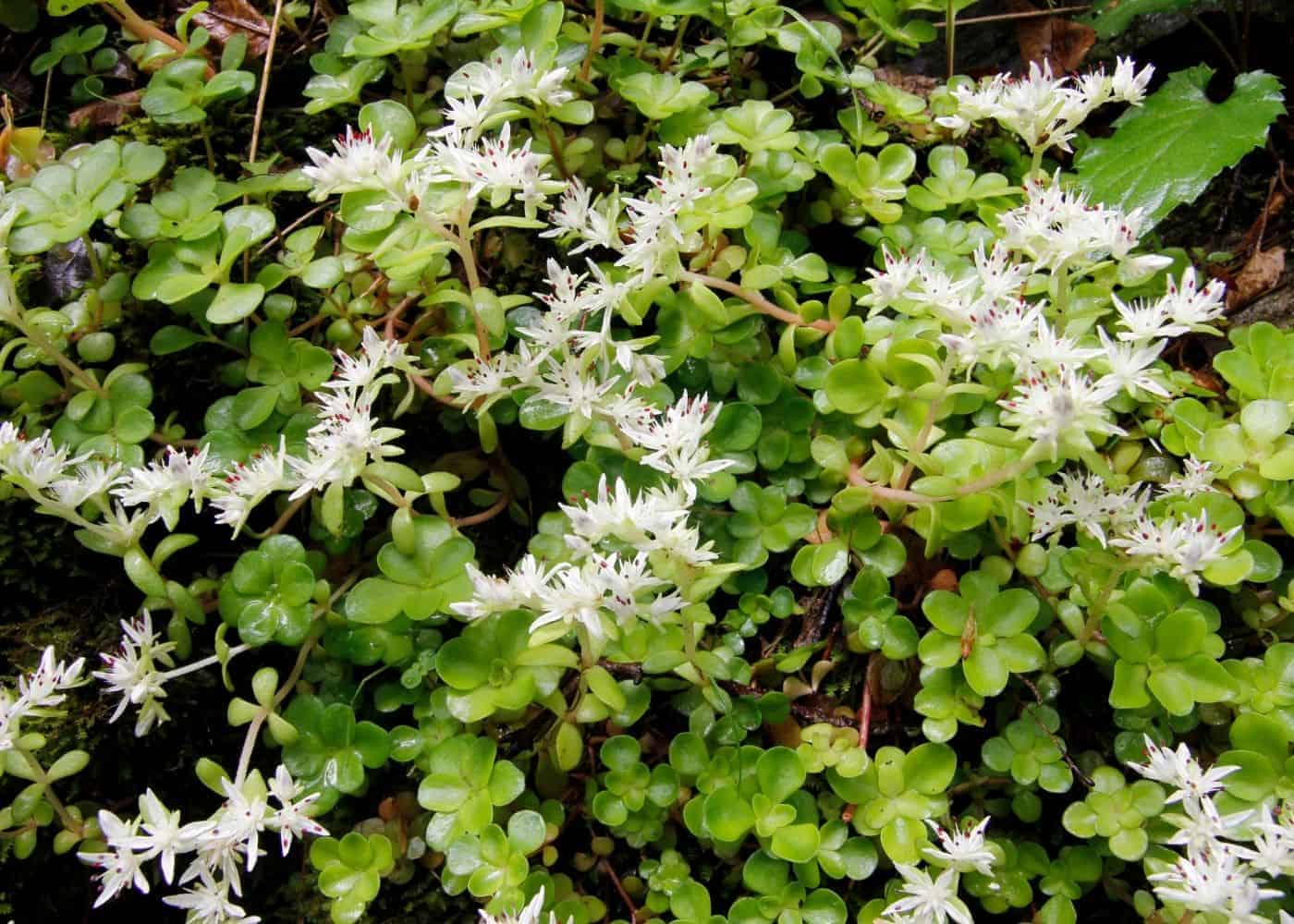
3. Sedum ternatum
Sedum Ternatum is a Sedum species with white flowers that bloom in April-May. This type of Sedum is native to the Eastern USA and can be grown in Zones 4-8. Sedum ternatum is also called Wild Stonecrop, Woodland Stonecrop, and Three-Leaved Stonecrop.
Sedum Ternatum is a shade-tolerant species of Sedum. It grows well in partial shade as long as there is bright indirect light available. Sedum Ternatum can also be grown in full sun provided the roots have access to adequate amounts of moisture. Established plants tend to grow 6″ tall.
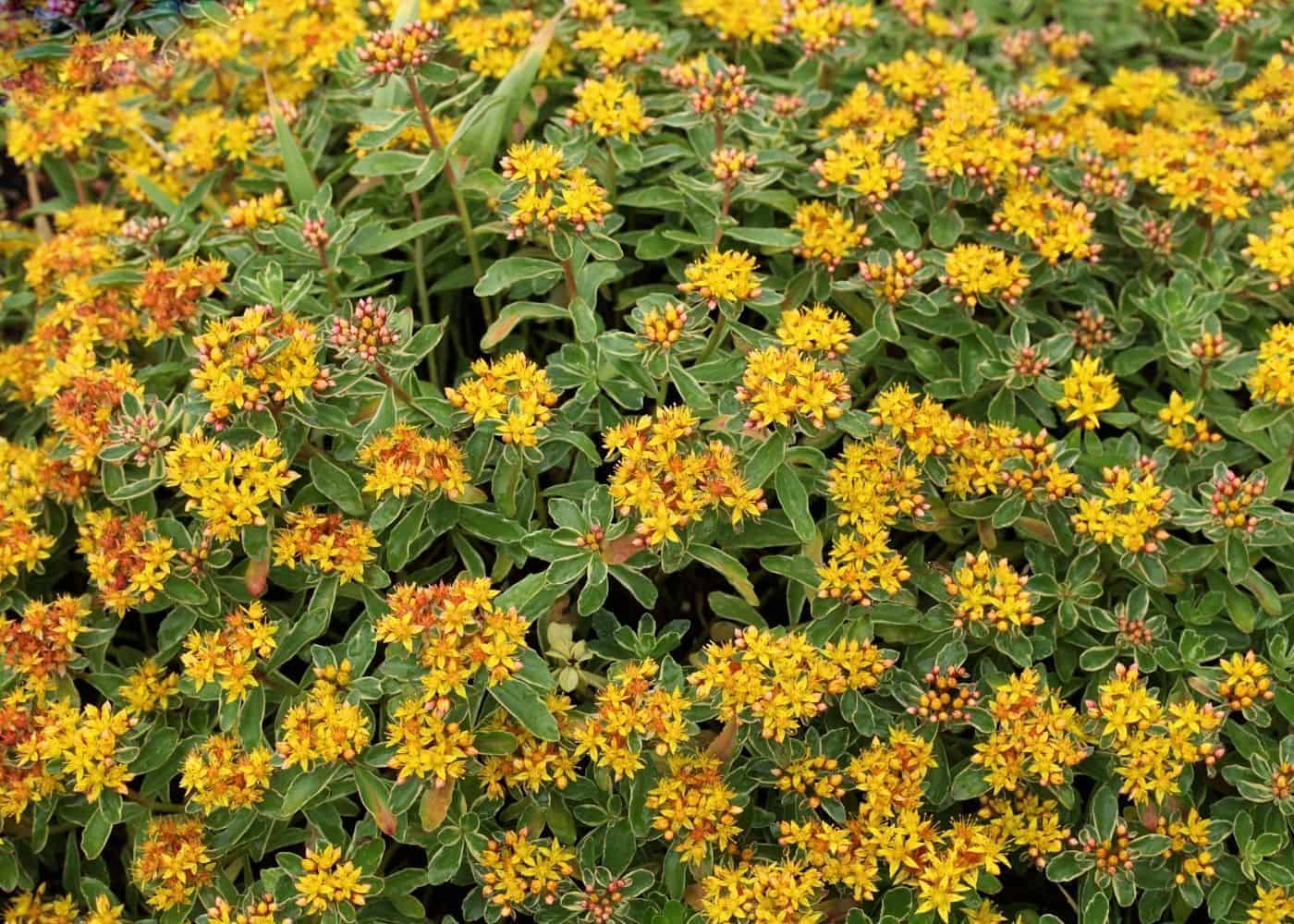
4. Sedum kamtschaticum
Sedum Kamtschaticum is a Sedum species with yellow-orange flowers that bloom in June-August. Sedum kamtschaticum (also called Phedimus kamtschaticus) is native to Siberia (namely the Kamchatka Peninsula) and can be grown in Zones 3-8. Sedum kamtschaticum is also called Orange Stonecrop, Russian Stonecrop, or Kamchatka Stonecrop. There are several popular cultivars, including ‘Variegatum’ and ‘Weihenstephaner Gold’ (several of which have received the RHS Award of Garden Merit in 1993).
Sedum kamtschaticum is a sun-loving and cold-tolerant Sedum species. It grows in dry soil but does require some moisture to thrive. Sedum kamtschaticum plants tend to grow 6″ tall, with clusters of flowers perched just atop the leaves.
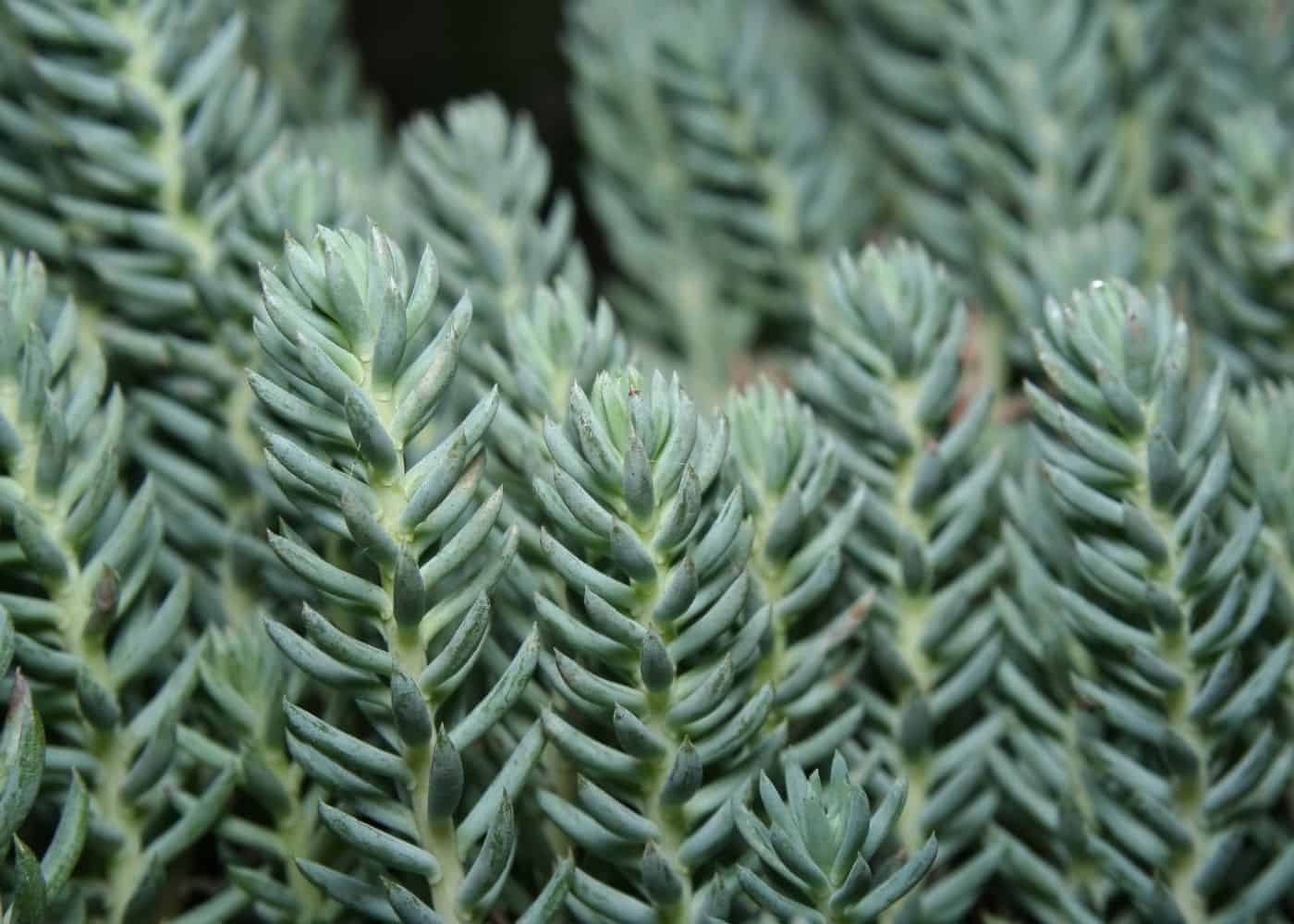
5. Blue Spruce sedum
Blue Spruce Sedum (Sedum reflexum ‘Blue Spruce’) is a Sedum cultivar with yellow flowers that typically bloom in June-July. Sedum reflexum is native to Europe and can be grown in Zones 3-8. Sedum reflexum ‘Blue Spruce’ is also called Blue Spruce Stonecrop or Blue Spruce Sedum. This cultivar is named for its needle-like foliage which resembles a Blue Spruce tree.
Blue Spruce Sedum grows best in full-sun locations and can be quite tolerant of drought once established. Sedum reflexum ‘Blue Spruce’ plants grow to be about 6″-9″ tall.
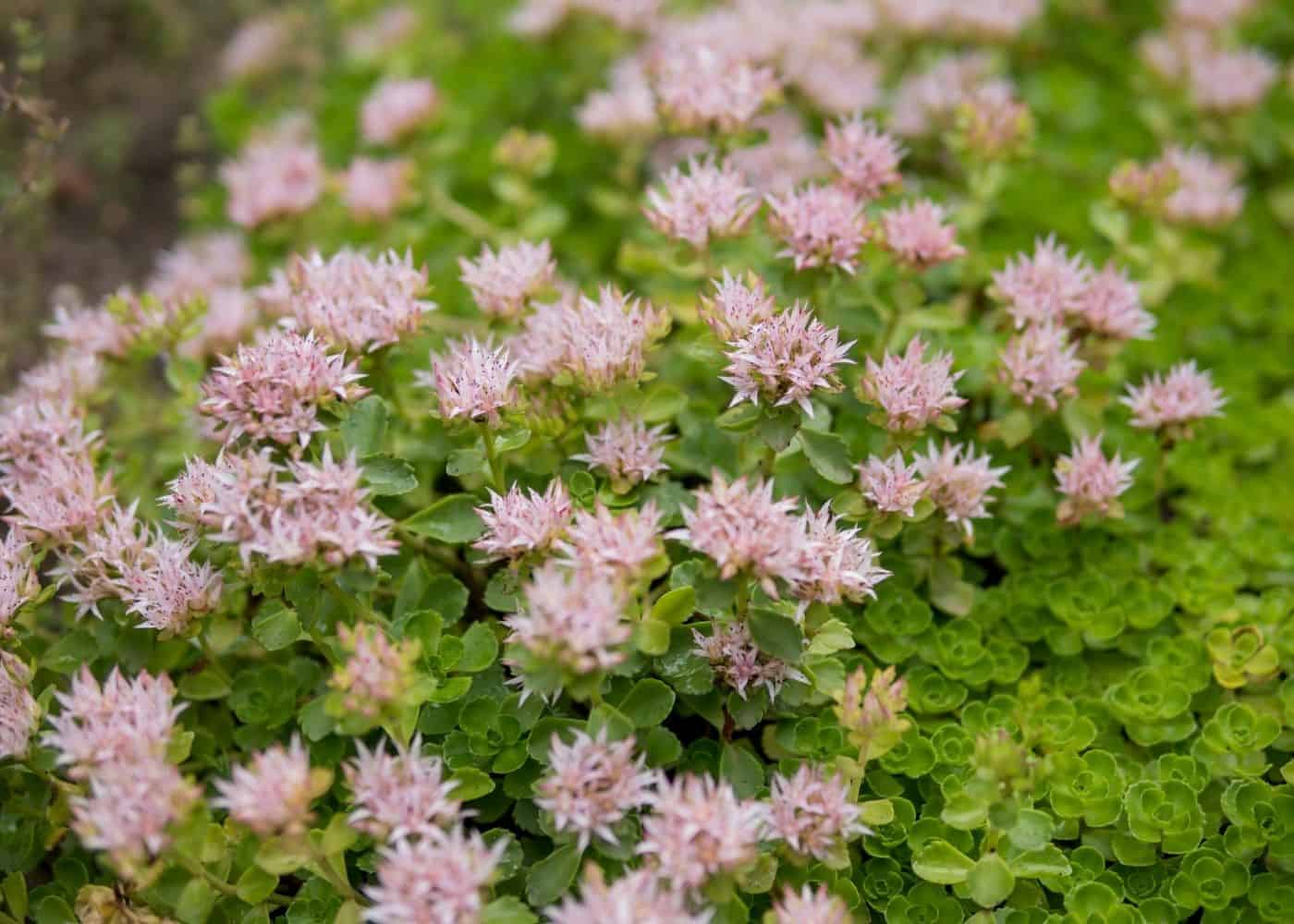
6. John Creech sedum
John Creech Sedum (Sedum spurium ‘John Creech’) is a cultivar of S. spurium with pink-lavender flowers that bloom in August-September. Sedum spurium is native to the Caucasus region in Southeastern Europe/Southwestern Asia and can be grown in Zones 3-8. ‘John Creech’ Sedum is a selected cultivar known for its attractive succulent leaves and soft pink-purple flowers. The variety is named for collector Dr. John Creech, who was the director of the U.S. National Arboretum from 1973-1980.
John Creech Sedum is a sun-loving type of Sedum that grows best in locations with more than 6 hours of direct sunlight daily. This drought-tolerant variety is tolerant of sandy soils and soils with low levels of nutrients. John Creech Sedum is a particularly low-growing variety, with established plants growing to a height of only 2″-4″ tall.
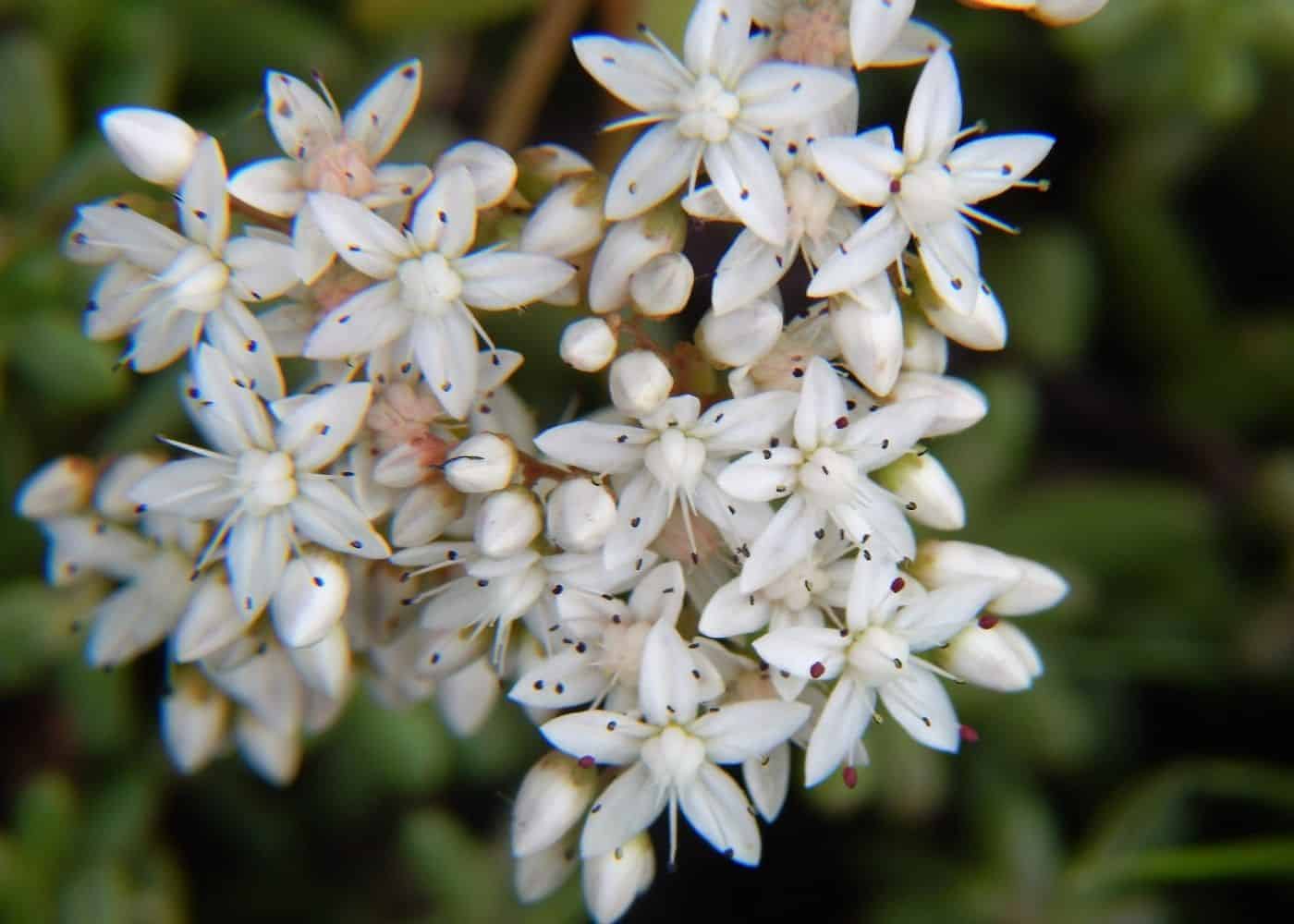
7. Sedum Album
Sedum Album is a Sedum species with white flowers that bloom in June-August. Sedum album is native to Europe, Western Asia, and North Africa, and can be grown in Zones 3-8. Sedum album is commonly called White Stonecrop or White Sedum.
Sedum Album grows best in sunny growing locations. Like many other Sedums, this type is drought-tolerant once established (and also tolerant of sandy and even gravelly soils). Sedum Album plants tend to grow to about 4″-6″ high.
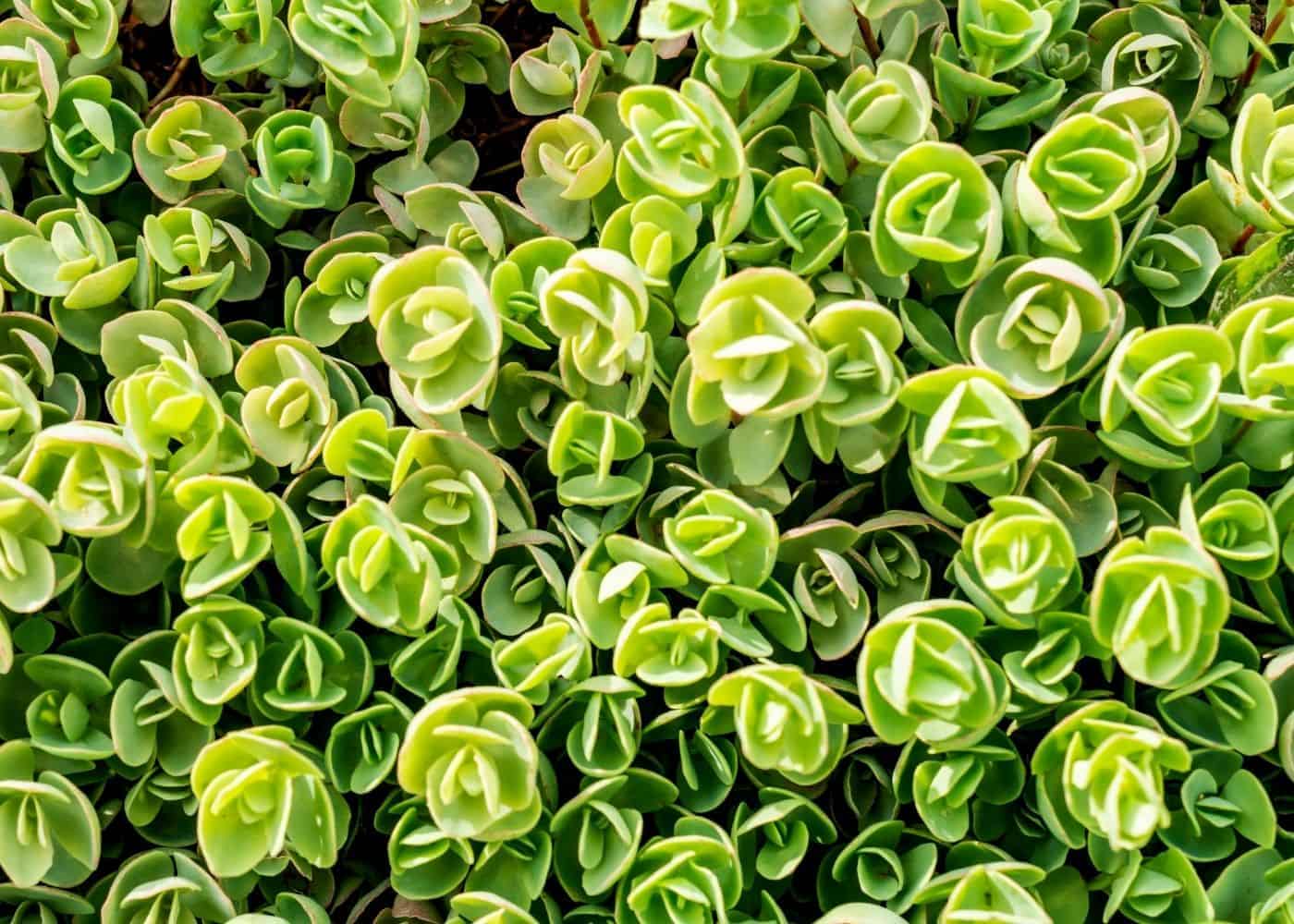
8. Coral Reef sedum
Coral Reef Sedum (Sedum tetractinum ‘Coral Reef’) is a Sedum cultivar with green leaves and soft-pink flowers that bloom in July-August. Sedum tetractinum is native to China and is sometimes called Chinese Sedum. It can be grown in Zones 4-8.
Coral Reef Sedum is tolerant of hot, sunny spots in the garden. It can also be grown in light shade, as long as plenty of bright indirect light is available. Established plants grow to a height of 3″-4″ tall.
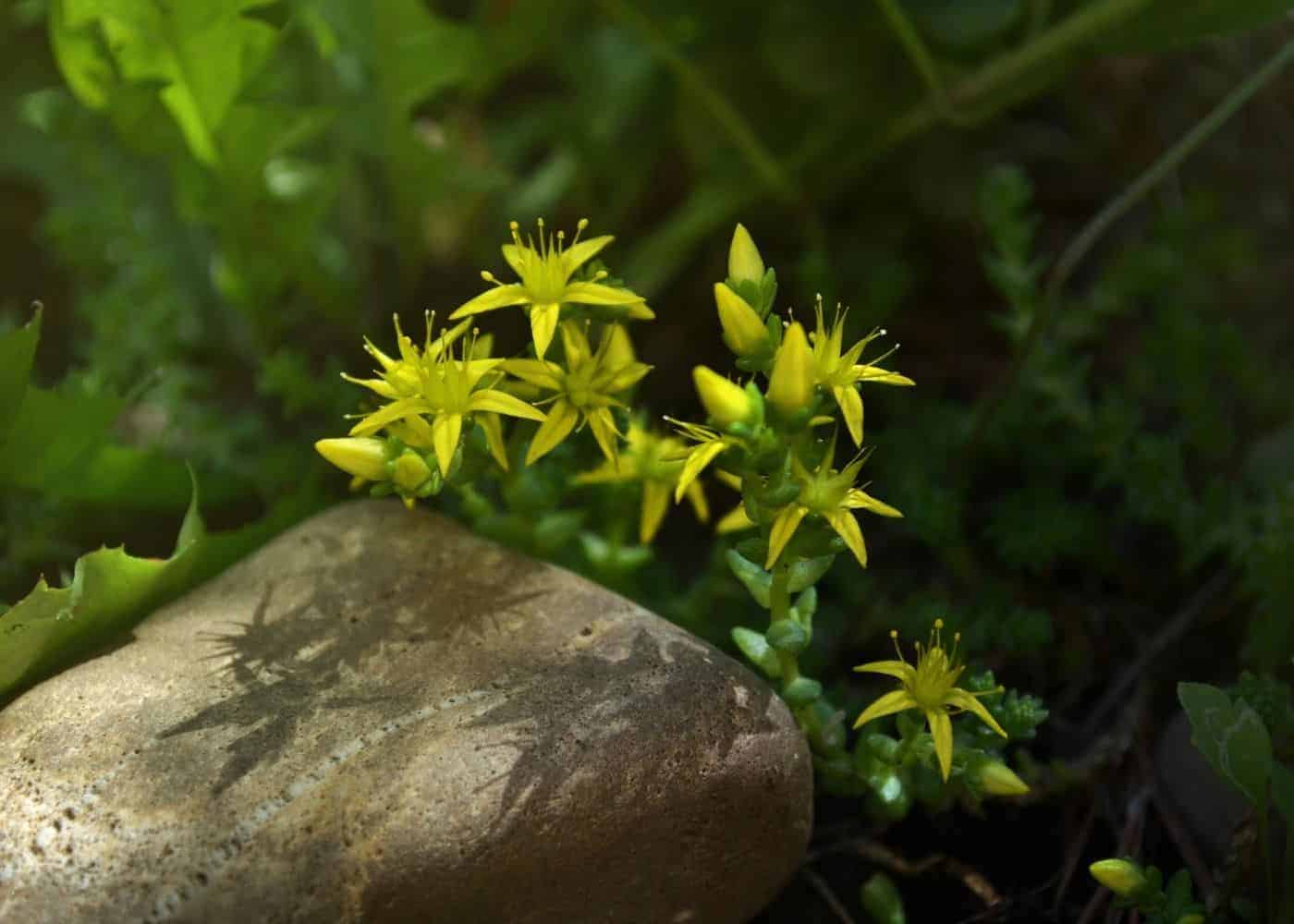
9. Sedum Stenopetalum
Sedum Stenopetalum is a species of Sedum with yellow flowers that bloom in June-July. Sedum stenopetalum is native to the Western USA and Canada and can be grown in Zones 5-9. Sedum stenopetalum is also called Wormleaf Stonecrop or Golden Constellation (after its masses of yellow flowers).
Sedum Stenopetalum is tolerant of gravelly soil and hot planting locations. Once established, this plant is very drought-tolerant. Plants typically grow to 6″-10″ tall.
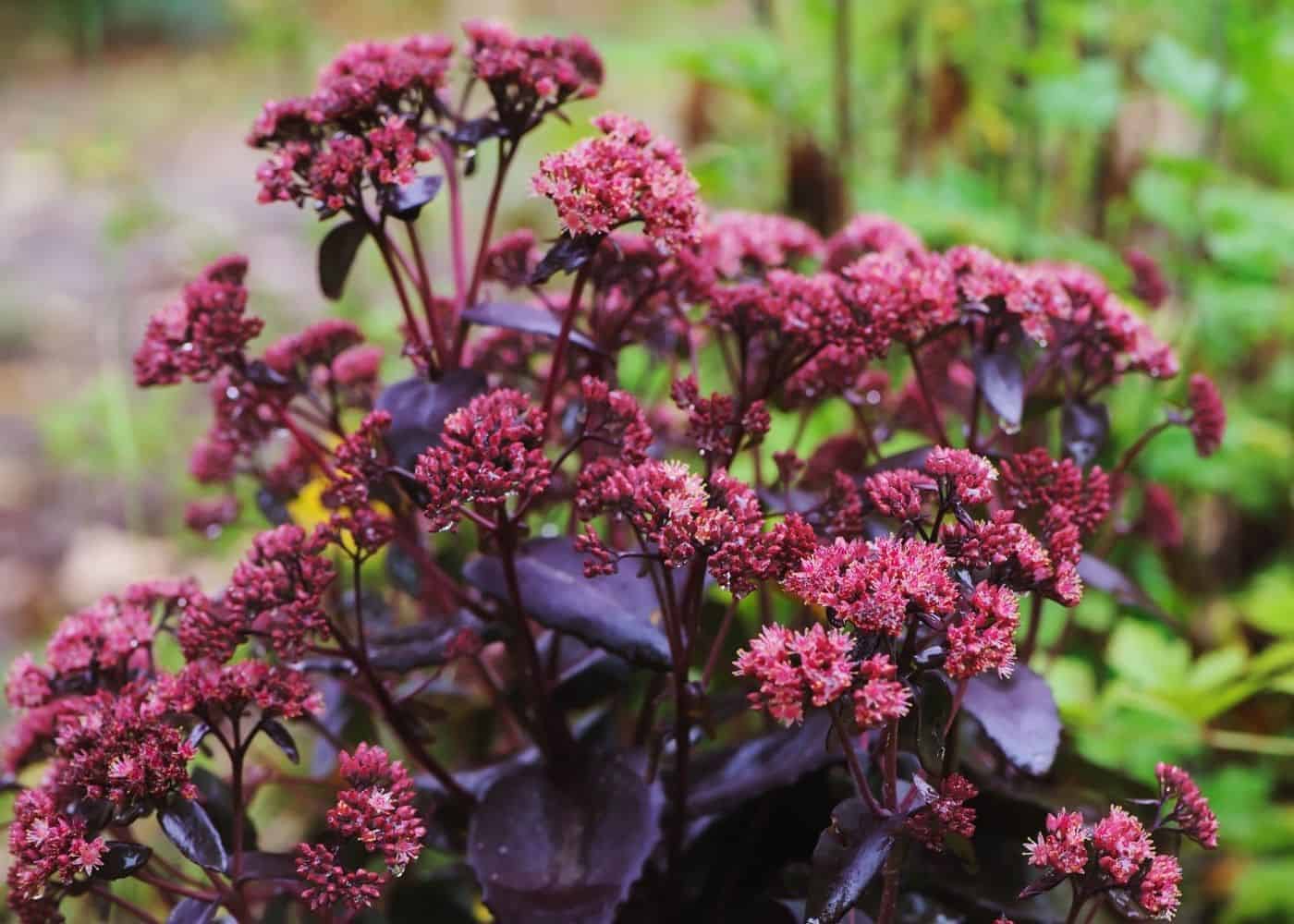
10. Purple Emperor sedum
Purple Emperor Sedum (Sedum telephium ‘Purple Emperor’ or Hylotelephium telephium ‘Purple Emperor’) is a purple-leaved sedum with pink-purple flowers that bloom in July-September. Hylotelephium telephium is native to parts of Europe and Asia and can be grown in Zones 3-7. Hylotelephium telephium is sometimes called Orpine. This selected cultivar received the RHS Award of Garden Merit in 2006.
Purple Emperor Sedum grows best in full sun but can tolerate light shade if adequate indirect light is available. The rich burgundy color tends to develop its richest hues in full sun planting locations. This plant grows best in well-drained soils that aren’t overly rich in nutrients. Purple Emperor Sedum typically grows to reach 18″-24″ tall.
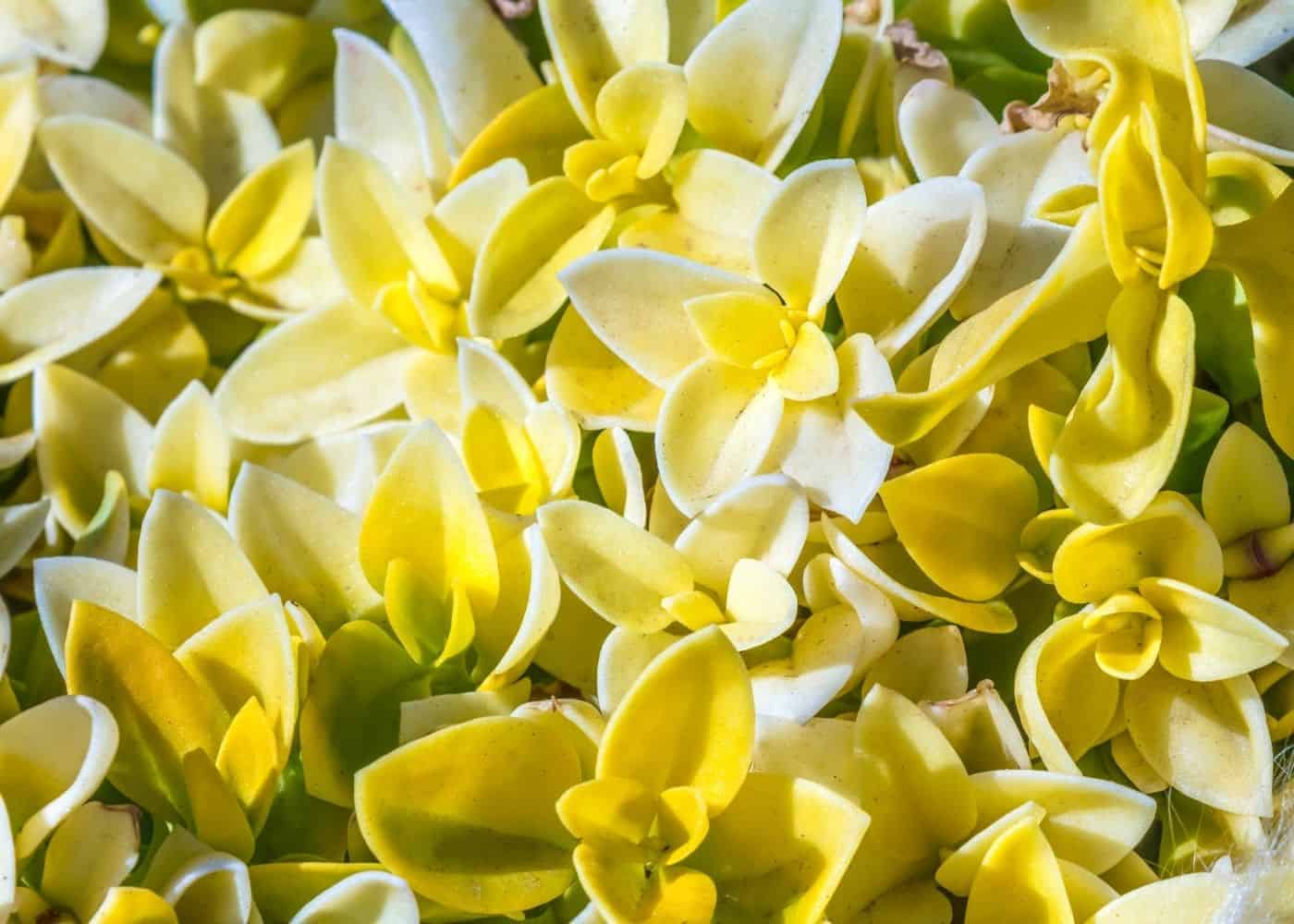
11. Ogon Sedum
Ogon Sedum (Sedum makinoi ‘Ogon’) is a cultivar of Sedum with yellow-green foliage and flowers that bloom in August-September. Sedum makinoi is sometimes called Japanese Stonecrop or Golden Japanese Stonecrop and can be grown in Zones 6-9.
Ogon Sedum is a versatile type that can be grown in full sun to partial shade. This type of sedum is more prone to sunburn than some other types and generally grows best with some afternoon shade in climates with the particularly harsh summer sun. Ogon Sedum is quite a low-growing Sedum, reaching only 2″-3″ tall.
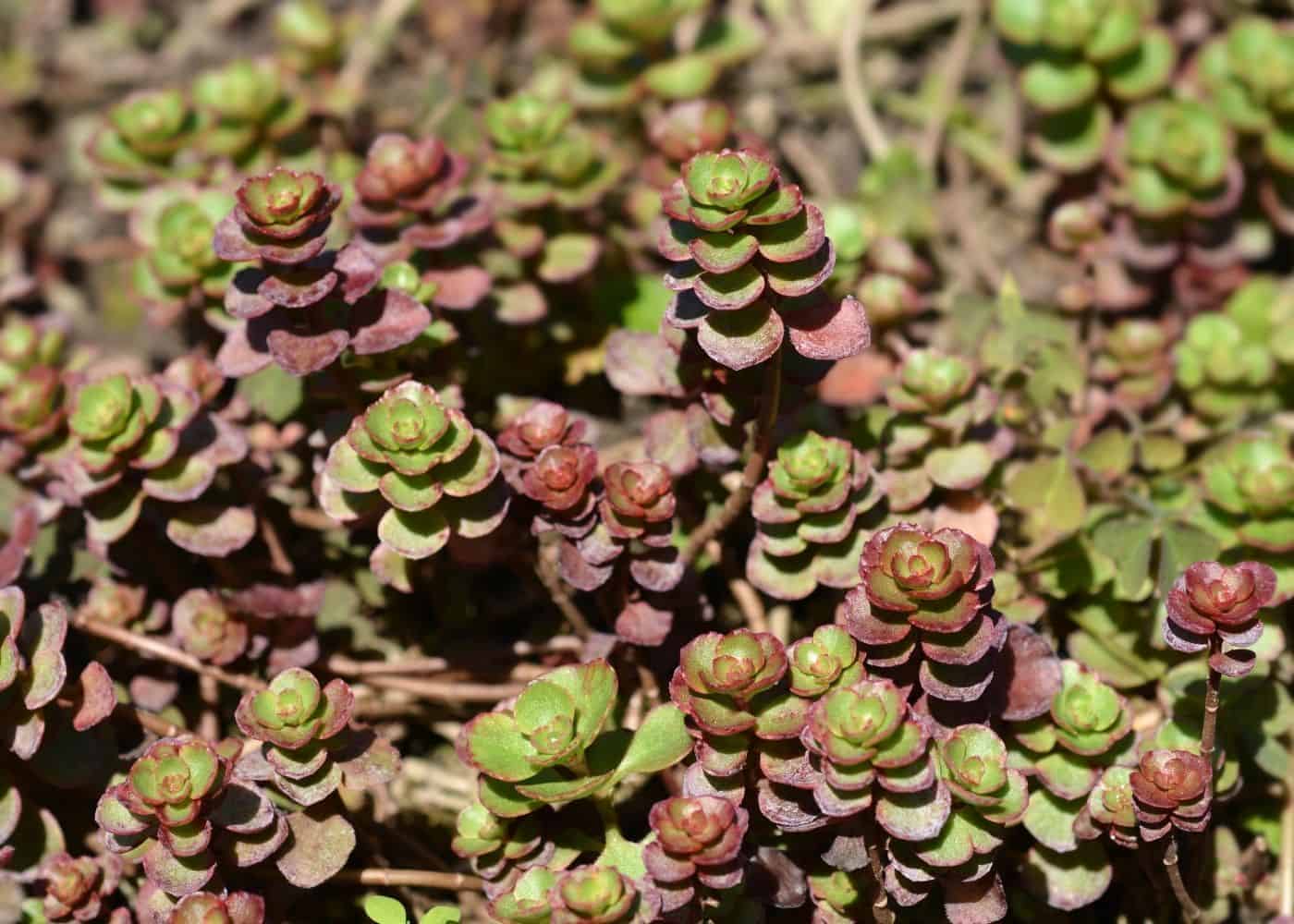
12. Fuldaglut Sedum
Fuldaglut Sedum (Sedum spurium ‘Fuldaglut’) is a cultivar of S. spurium with red flowers that bloom in August-September. Sedum spurium is native to the Caucasus region in Southeastern Europe/Southwestern Asia and can be grown in Zones 3-8. ‘Fuldaglut’ Sedum is a selected cultivar known for its maroon-colored leaves and ruby-red blooms. Fuldaglut Sedum is sometimes called Crimson Stonecrop.
Fuldaglut Sedum is a sun-loving type of Sedum that grows best in locations with more than 6 hours of direct sunlight each day. This low-maintenance plant thrives in dry, well-drained soils once established (although some watering is required in particularly dry gardens). Fuldaglut Sedum is low-growing and tends to grow to 2″-3″ tall.
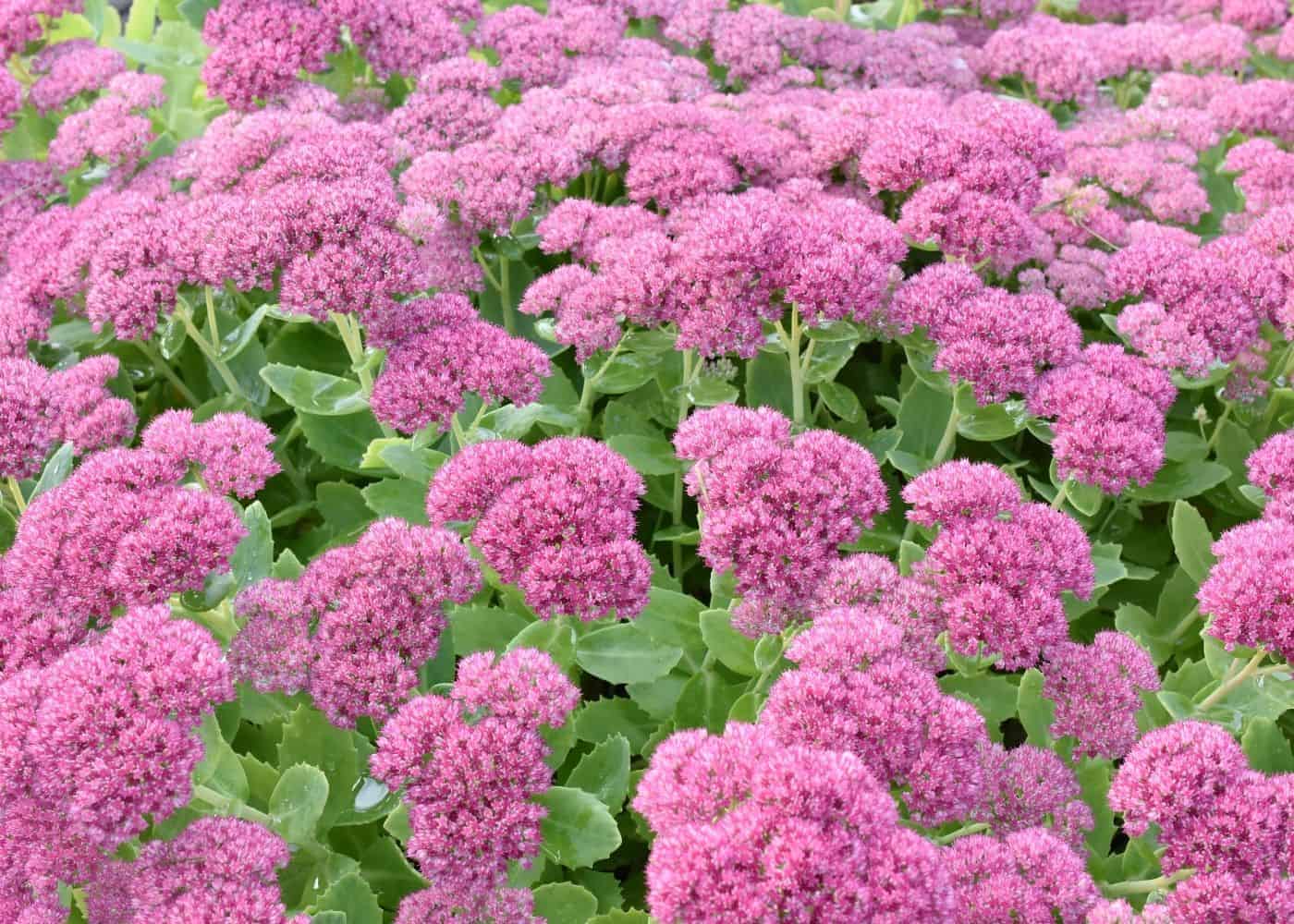
13. Sedum Ewersii
Sedum Ewersii (Hylotelephium ewersii) is a stonecrop species with pink flowers that blooms in August-September. Hylotelephium ewersii is native to Asia, and can be grown in Zones 4-9. Sedum Ewersii is also called Mongolian Stonecrop or Pink Mongolian Stonecrop.
Sedum Ewersii is versatile, and can be grown in full sun to partial shade. This type is drought-tolerant and tolerant of nutrient-poor soil. Plants typically reach 4″-6″ tall.
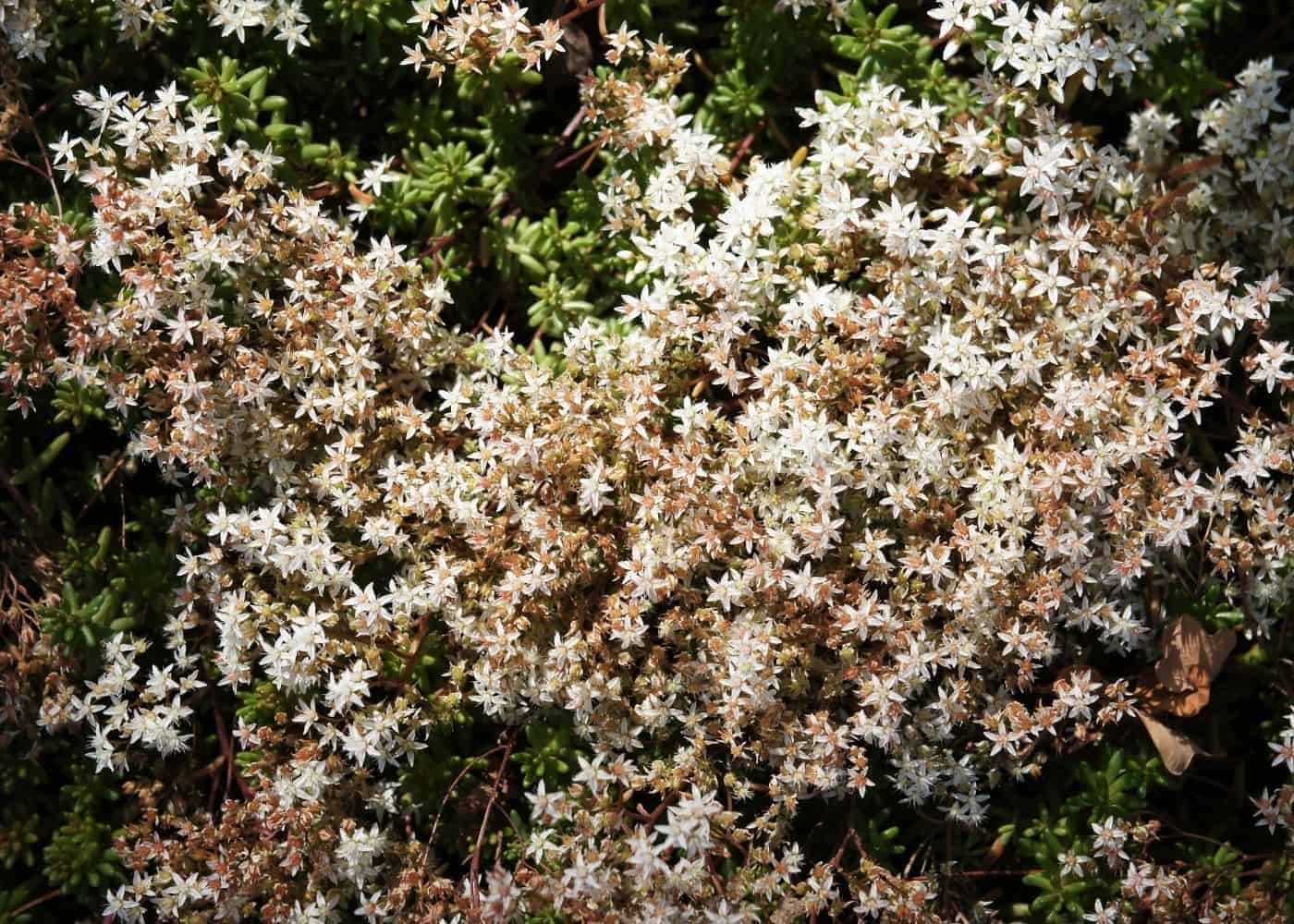
14. Sedum Murale
Sedum Murale (Sedum album subsp. teretifolium ‘Murale’) is a cultivar of White Stonecrop that tends to grow shorter than other white-flowering varieties. Like other White Stonecrops, this plant thrives in Zones 3-9.
Sedum Murale grows best in full sun planting locations with soil that drains easily. This variety grows to about 3″ tall, making it a gorgeous flowering groundcover plant option.
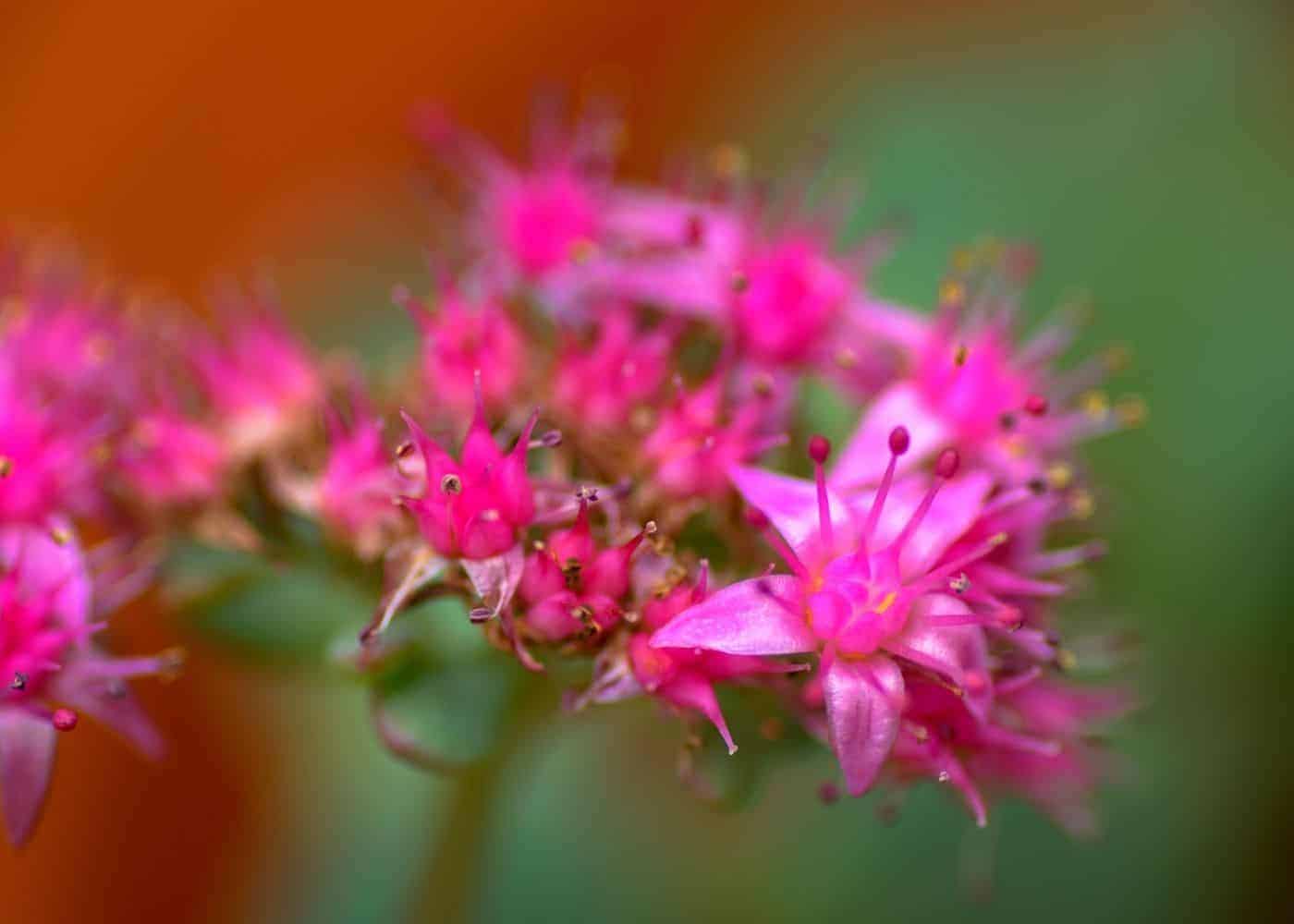
15. Lidakense Sedum
Lidakense Sedum (Sedum cauticola ‘Lidakense’ or Hylotelephium cauticola ‘Lidakense’) is a Sedum variety with pink flowers that bloom in August-September. Hylotelephium cauticola is native to Japan, and can be grown in Zones 2-9 (making it one of the most cold-hardy types of Sedum). Lidakense Stonecrop is also called Pink Stonecrop or Cliff Stonecrop.
Lidakense Sedum is very versatile and can be grown in hot and dry locations or in partially shaded spots. This easy-care plant has very low water requirements for such a beautiful flowering plant. Plants grow to 2″-4″ tall. Sedum cauticola ‘Lidakense’ received the RHS Award of Garden Merit in 2006.
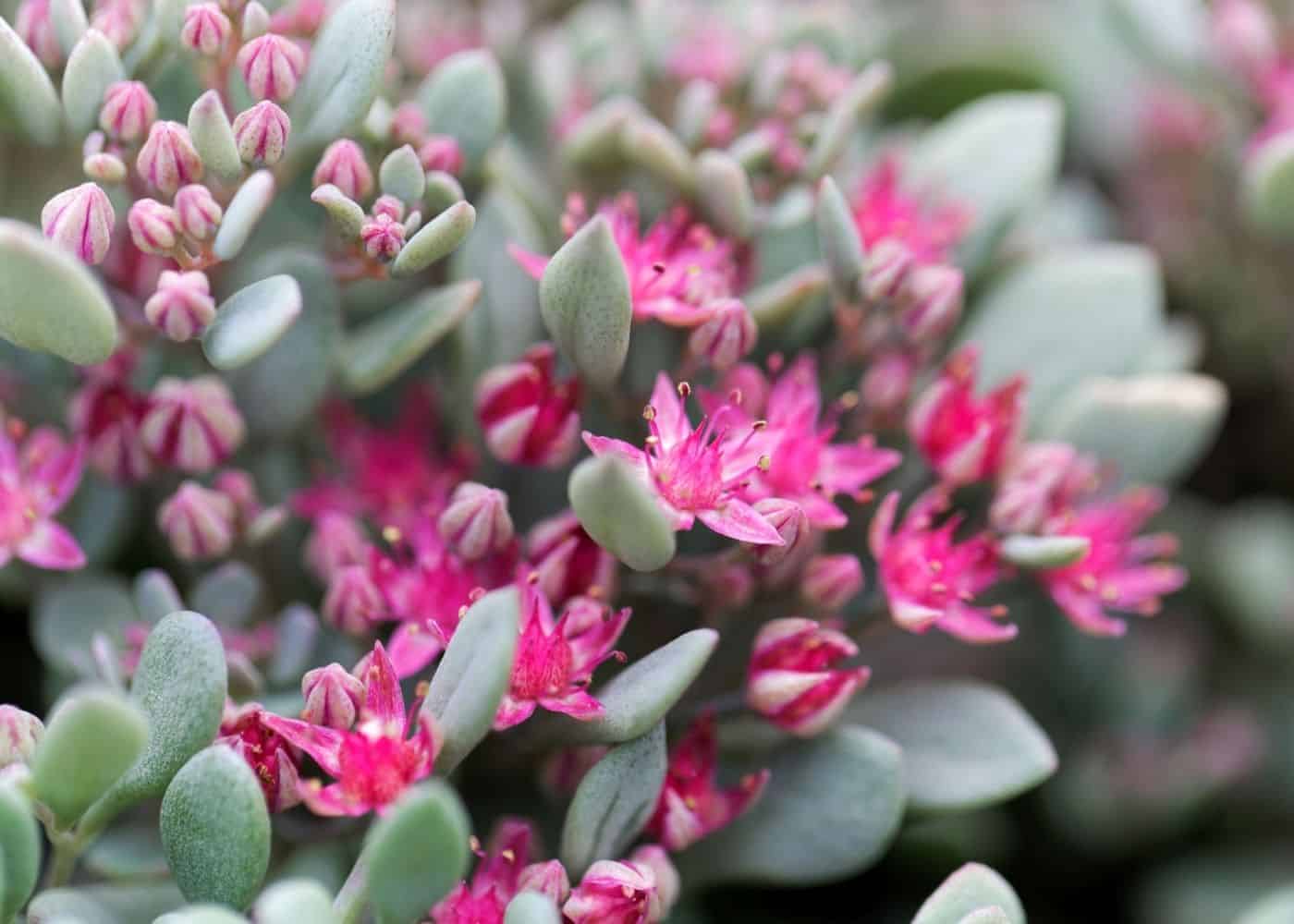
16. Hylotelephium Sieboldii
Hylotelephium Sieboldii is a stonecrop species with bright pink flowers that bloom in August-October. Native to Japan, this variety can be grown in Zones 4-9. Hylotelephium sieboldii (formerly Sedum sieboldii) is also called October Stonecrop, Siebold’s Stonecrop, or October Daphne.
Hylotelephium sieboldii grows best in full-sun locations with well-drained soil. The plant grows 8″-10″ tall, but is also commonly grown as a trailing container plant. The cultivar ‘Misebaya-nakafu’ received the RHS Award of Garden Merit in 1993.
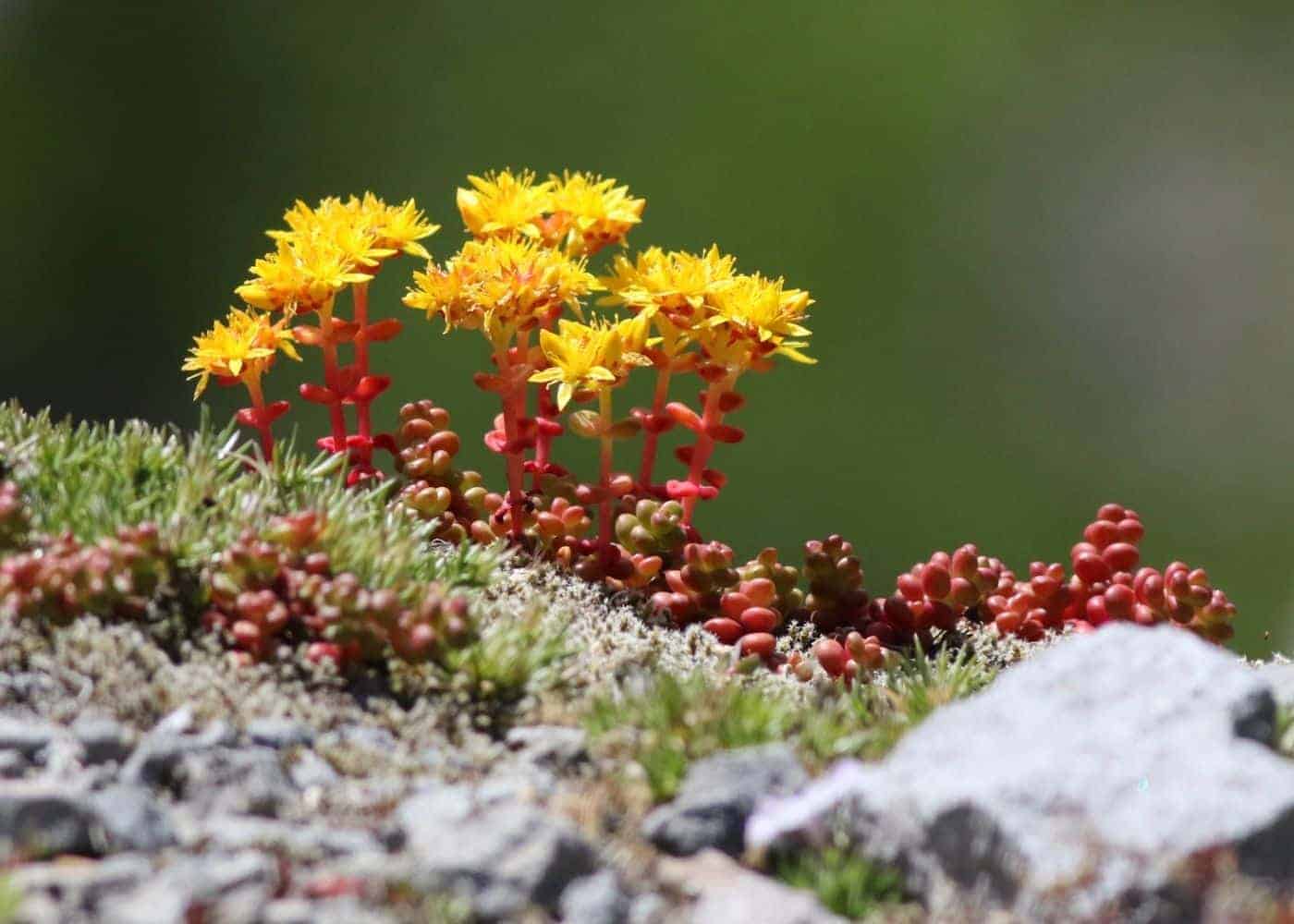
17. Sedum Divergens
Sedum Divergens is a type of Sedum with bright yellow flowers that bloom in June-July. Sedum divergens is native to the Western USA and Canada. Sedum divergens is also called Pacific Stonecrop and Cascade Stonecrop.
Sedum divergens can be grown in full sun to partial shade (although it flowers best in full sun locations). This plant is particularly tolerant of nutrient-poor soils. Established plants grow to reach 4″-6″ tall.
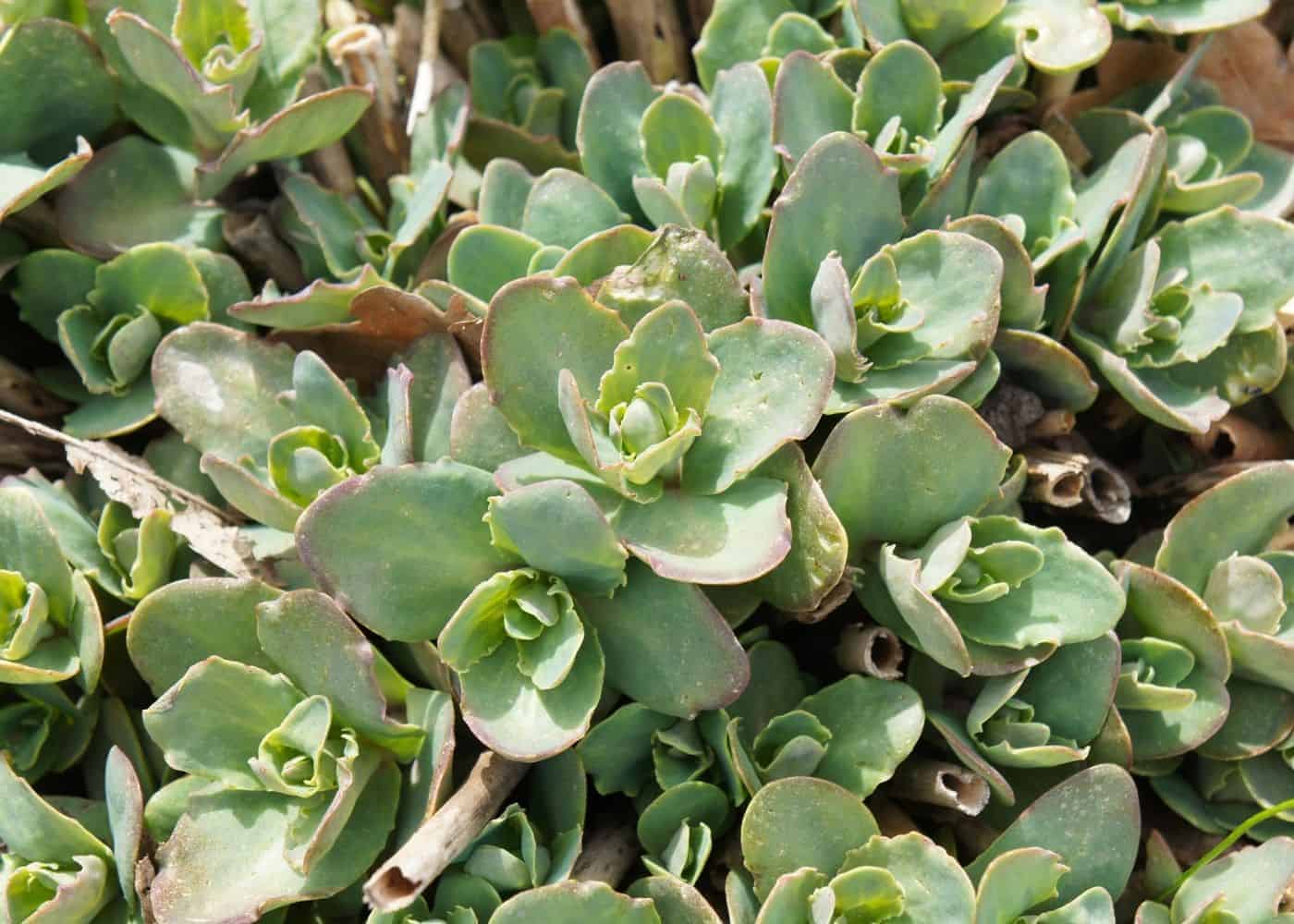
18. Rose Carpet sedum
Rose Carpet Sedum (Sedum ewersii var. homophyllum ‘Rose Carpet’ or Hylotelephium ewersii ‘Rose Carpet’) is a Sedum variety with bright pink flowers that bloom in August-September. The species is native to Asia, and this cultivar can be grown in Zones 3-9.
Rose Carpet Sedum grows best in full sun planting locations with well-drained soil. Established Rose Carpet Sedum plants grow 4″-6″ tall, making this an excellent colorful ground cover option.
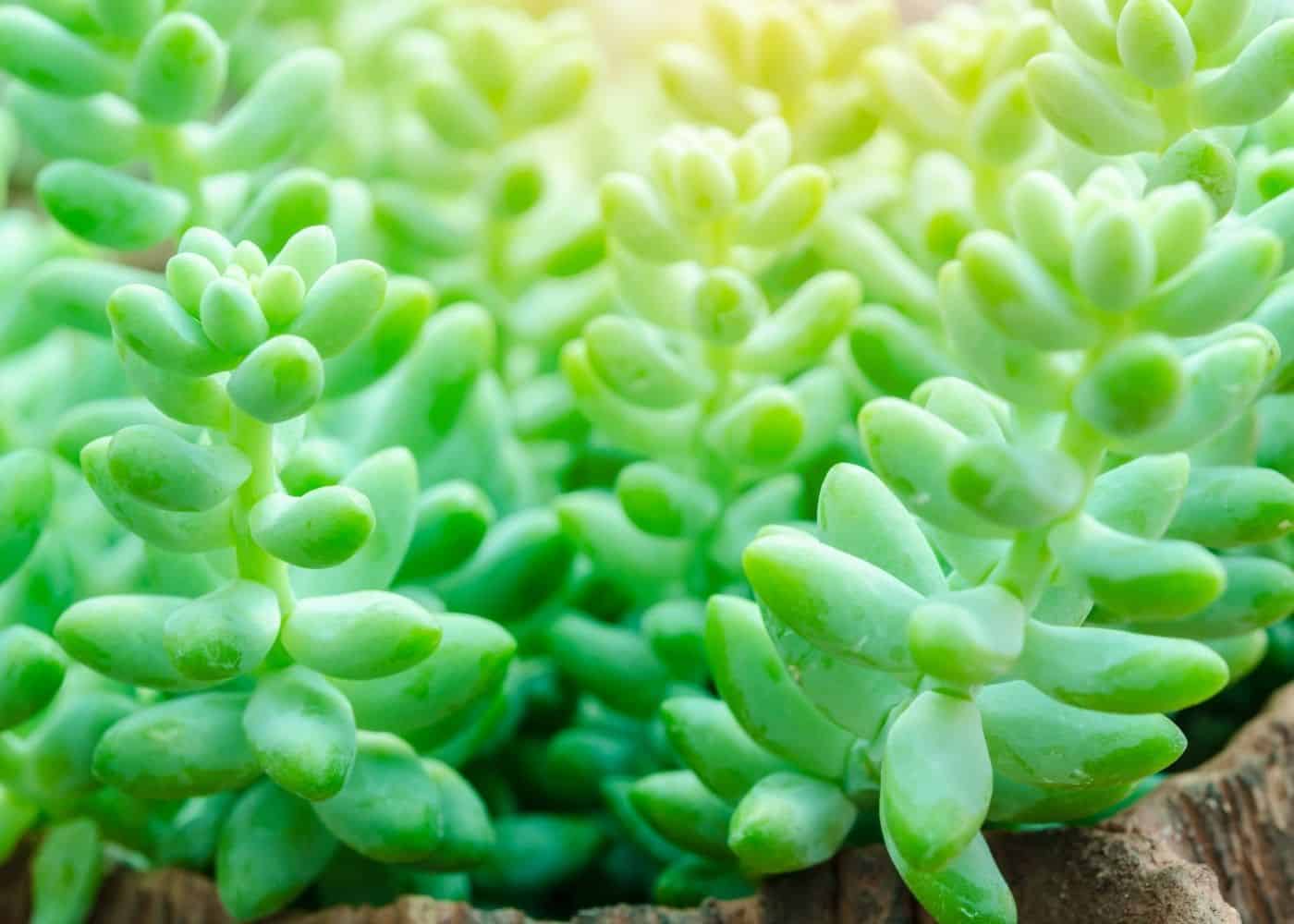
19. Burrito sedum
Burrito Sedum (Sedum morganianum ‘Burrito’) is a Sedum variety grown mainly for its fleshy blue-green leaves. Sedum morganianum is native to Central America, and can be grown in Zones 10-11 (or more commonly as an indoor houseplant). Burrito Sedum is also called Donkey’s Tail Sedum or Burro’s Tail Sedum. The ‘Burrito’ cultivar has more rounded leaves than wild specimens.
Burrito Sedum is drought-tolerant and is well-adapted to mild indoor temperatures. Like many other succulents, this plant should not be overwatered (and should be planted in well-drained soil). The stems tend to trail (rather than growing upright), reaching 18″-24″ long.
Sedum morganianum received the RHS Award of Garden Merit in 1993.
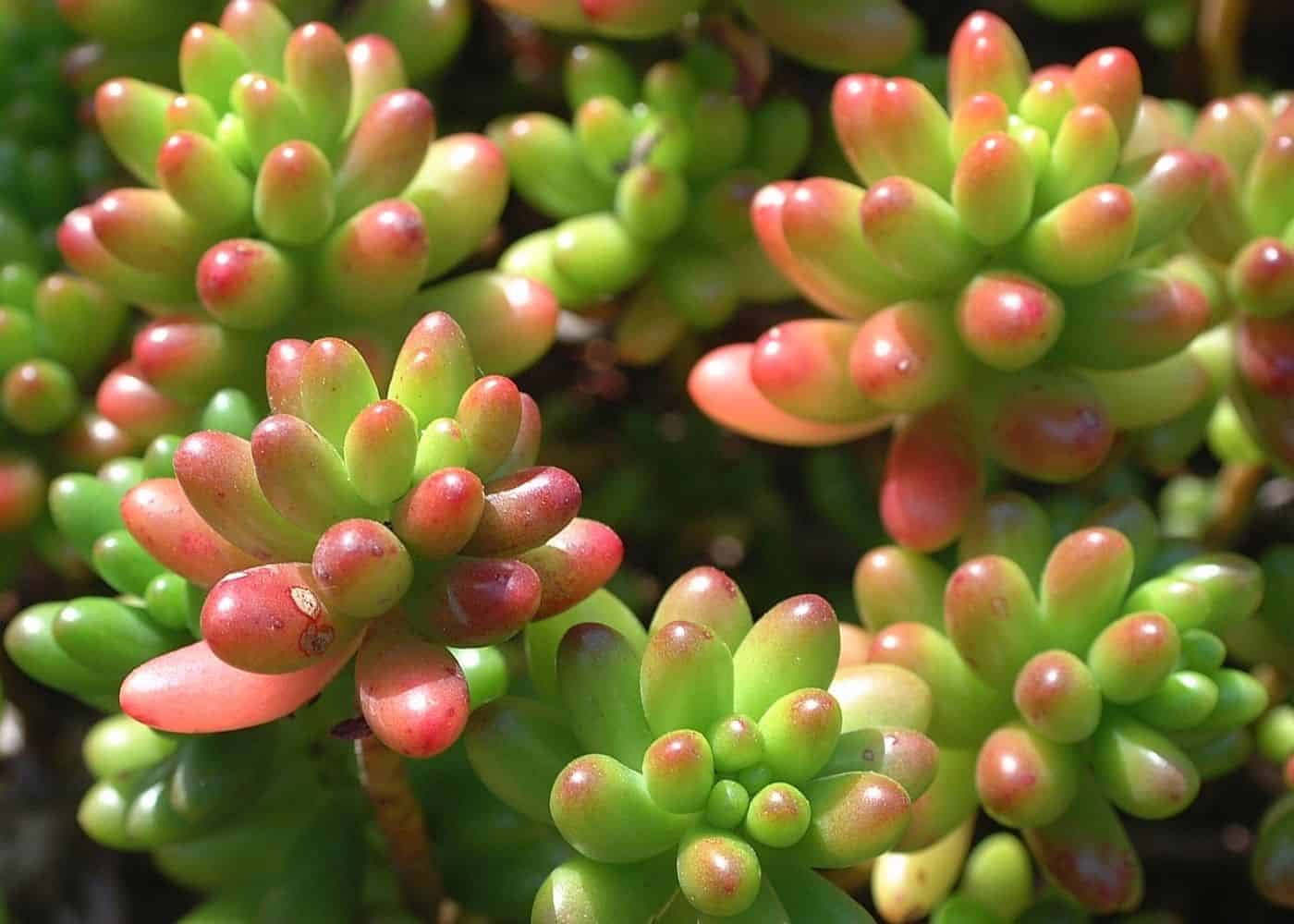
20. Brown Bean Sedum
Brown Bean Sedum (Sedum rubrotinctum ‘Brown Bean’) is a Sedum variety grown mainly for its ornamental green-red foliage. Sedum rubrotinctum is native to Mexico, and can be grown in Zones 9-11. This variety is commonly grown as an outdoor annual or as an indoor houseplant in cooler zones. Brown Bean Sedum is also called Jelly Bean Plant or Pork And Beans Plant due to its fleshy succulent leaves.
Brown Bean Sedum is drought-tolerant and its soil should be allowed to dry out between waterings. Full sun planting locations and light exposure will help the foliage to develop its characteristic red hue (which protects the fleshy leaves from harsh sunlight). Plants tend to reach 4″-6″ high with trailing stems.
